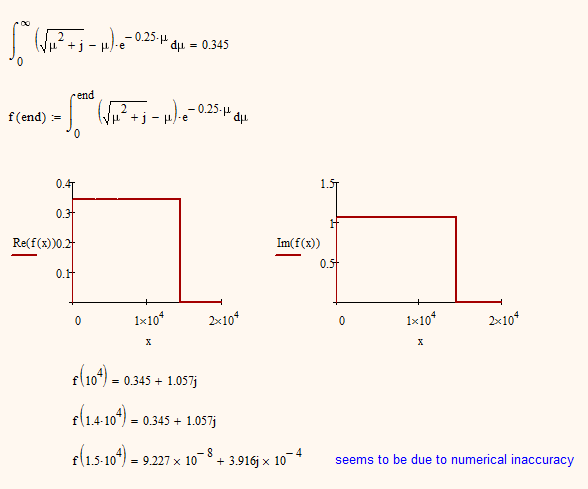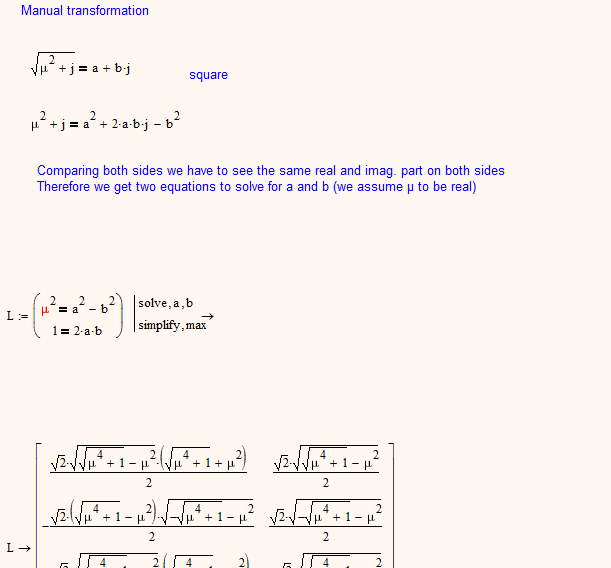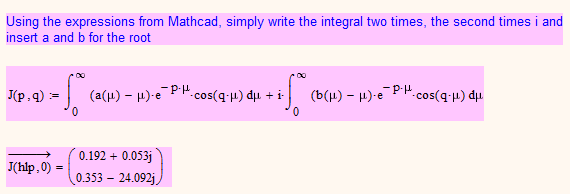Community Tip - Visit the PTCooler (the community lounge) to get to know your fellow community members and check out some of Dale's Friday Humor posts! X
- Subscribe to RSS Feed
- Mark Topic as New
- Mark Topic as Read
- Float this Topic for Current User
- Bookmark
- Subscribe
- Mute
- Printer Friendly Page
The solution of the integral below should have an imaginery part but only shows the real part
- Mark as New
- Bookmark
- Subscribe
- Mute
- Subscribe to RSS Feed
- Permalink
- Notify Moderator
The solution of the integral below should have an imaginery part but only shows the real part
I need to calculate the semi-infinite integral that appears in the attached pdf file and the solution should have imaginary part. But, for some reason that I do not know, it is just given me the real part.
j inside the integral is the imaginery term.
Thank you in advance,
Rogelio
Solved! Go to Solution.
- Labels:
-
Calculus_Derivatives
Accepted Solutions
- Mark as New
- Bookmark
- Subscribe
- Mute
- Subscribe to RSS Feed
- Permalink
- Notify Moderator
Second approach using a different program (Derive 6)

Using this information, Mathcad is able to yield the correct result:

Again with the help of Derive we can rewrite your function J so that even Mathcad yields the correct results:

- Mark as New
- Bookmark
- Subscribe
- Mute
- Subscribe to RSS Feed
- Permalink
- Notify Moderator
Attaching your worksheet using the advanced editor (see the upper right-hand area of the normal editor) will help people see what you are doing. I strongly suggest you do this.
- Mark as New
- Bookmark
- Subscribe
- Mute
- Subscribe to RSS Feed
- Permalink
- Notify Moderator
You are right, one would expect an imaginary part.
Numerical deficiency or bug? Guess the first.
Did you try symbolic eval? I had to stop - it took too long.

- Mark as New
- Bookmark
- Subscribe
- Mute
- Subscribe to RSS Feed
- Permalink
- Notify Moderator
Second approach using a different program (Derive 6)

Using this information, Mathcad is able to yield the correct result:

Again with the help of Derive we can rewrite your function J so that even Mathcad yields the correct results:

- Mark as New
- Bookmark
- Subscribe
- Mute
- Subscribe to RSS Feed
- Permalink
- Notify Moderator
Mr. Werner,
I really like what you have done here.
But I do not "see" how you arrive to this form for the square root complex component.
Can you give me a reference where i can read about this?
I have several problems to solve that will all include this kind of solutions. If I can learn how to arrive to these complex component, in the way that you did, that will be terrific!!
Thank you very much for all your help.
Regards,
Rogelio
- Mark as New
- Bookmark
- Subscribe
- Mute
- Subscribe to RSS Feed
- Permalink
- Notify Moderator
Rogelio de las Casas wrote:
Mr. Werner,
I really like what you have done here.
But I do not "see" how you arrive to this form for the square root complex component.
Can you give me a reference where i can read about this?
I have several problems to solve that will all include this kind of solutions. If I can learn how to arrive to these complex component, in the way that you did, that will be terrific!!
Thank you very much for all your help.
Regards,
Rogelio
Sorry, as already written I have not done the transformation myself by hand but had used another math program to do the job and simply retyped it. Later I tried if Mathcads symbolics would do the trick (using the modifier rectangle) but I had no succes - maybe I tried not hard enough, as Mathcads symbilics can be quite tricky.
See attached.
I have just gave it a try and found a way to do the transformation manually with the term, that can throw complex results, using Mathcad only to solve a system of equations. Don't worry about the red errors, they apply only to numerics, we use symbolics here. It would be more correct to write L(my):=...
and a(my):=L(my)[0,0 etc.

- Mark as New
- Bookmark
- Subscribe
- Mute
- Subscribe to RSS Feed
- Permalink
- Notify Moderator
Thank you, that was good and looks simpler after you explained it.
I really appreciate all your help on this.
Regards,
Rogelio
- Mark as New
- Bookmark
- Subscribe
- Mute
- Subscribe to RSS Feed
- Permalink
- Notify Moderator
Glad I could help.
Its a shame that Mathcad doesn't do it on its own.
After thinking over it I have to change my mind - it seems to be a bug
But at least we have a workaround, thanks Derive.
BTW, the same error (the integral yielding the realparts only) is seen in Prime2, too.
- Mark as New
- Bookmark
- Subscribe
- Mute
- Subscribe to RSS Feed
- Permalink
- Notify Moderator
Werner,
I tried the solution of mathcad for the square function from your previous message and it did not work.
I have attached the file that you sent me first with some comments.
The good thing is that your first solution from Derive, did work very well and I could reproduce the examples from the paper that I was studying.
Thanks again
Rogelio
- Mark as New
- Bookmark
- Subscribe
- Mute
- Subscribe to RSS Feed
- Permalink
- Notify Moderator
I am not sure if we see the same, if its a version conflict (I am using Mathcad 15 M020) or maybe only a misunderstanding.
I include a worksheet with a manual proof that the expressions by derive and MC are equivalent.
Also a pdf of the file so you see how it looks for me
- Mark as New
- Bookmark
- Subscribe
- Mute
- Subscribe to RSS Feed
- Permalink
- Notify Moderator
I added at the end a definition of J based on the results from Mathcad and it seems to wirk well.
I furthermore added the parameters so that the numerics are happy, too, now.

- Mark as New
- Bookmark
- Subscribe
- Mute
- Subscribe to RSS Feed
- Permalink
- Notify Moderator
Yes, you are right.
when I did the simplification, i did not notice that whatever I have at the end equals 1 !!
Thanks,





